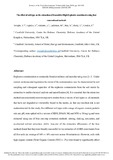- CERES Home
- →
- Cranfield Defence and Security
- →
- Staff publications (CDS)
- →
- View Item
JavaScript is disabled for your browser. Some features of this site may not work without it.
| dc.contributor.author | Temple, Tracey J. | |
| dc.contributor.author | Cipullo, S. | |
| dc.contributor.author | Galante, Erick | |
| dc.contributor.author | Ladyman, Melissa K. | |
| dc.contributor.author | Mai, Nathalie | |
| dc.contributor.author | Parry, T. | |
| dc.date.accessioned | 2019-03-13T12:56:23Z | |
| dc.date.available | 2019-03-13T12:56:23Z | |
| dc.date.issued | 2019-03-01 | |
| dc.identifier.citation | T. Temple, S. Cipullo, E. Galante, et al., The effect of soil type on the extraction of insensitive high explosive constituents using four conventional methods. Science of The Total Environment, Volume 668, June 2019, pp. 184-192 | en_UK |
| dc.identifier.issn | 0048-9697 | |
| dc.identifier.uri | https://doi.org/10.1016/j.scitotenv.2019.02.359 | |
| dc.identifier.uri | http://dspace.lib.cranfield.ac.uk/handle/1826/13984 | |
| dc.description.abstract | Explosive contamination is commonly found at military and manufacturing sites (Hewitt et al., 2005; Clausen et al., 2004; Walsh et al., 2013). Under current environmental legislation the extent of the contamination must be characterized by soil sampling and subsequent separation of the explosive contaminants from the soil matrix by extraction to enable chemical analysis and quantification (Dean, 2009). It is essential that the extraction method can consistently recover explosive residue from a variety of soil types i.e. all materials that have not degraded or irreversibly bound to the matrix, so that any resultant risk is not underestimated. In this study, five different soil types with a range of organic content, particle size and pH, were spiked with a mixture of RDX, DNAN, NQ and NTO at 50 mg/kg and were extracted using one of four one-step extraction methods: stirring, shaking, sonication, and accelerated solvent extraction (ASE). Analysis of the extraction efficiencies of the four methods found that they were broadly successful for the extraction of all IHE constituents from all five soils (an average of 84% ± 14% recovery across 80 extractions). However, soils with high organic content (Total Organic Content (TOC) ≥ 2%) were found to significantly affect extraction efficiency and reproducibility. NTO and DNAN were the least consistent in extraction efficiency with poorest recovery of NTO as low as 37% ± 2%. Of the four tested methods shaking was found to be the most reproducible, though less efficient than stirring (64%–91%). ASE was found to have the most variable results for extraction of IHE constituents suggesting that ASE was the most affected by the different soil types. Therefore, it is recommended that the efficiency and reproducibility of the selected extraction method should be validated by extracting known concentrations of the IHE from the soil of interest and that any required correction factors are reported. | en_UK |
| dc.language.iso | en | en_UK |
| dc.publisher | Elsevier | en_UK |
| dc.rights | Attribution-NonCommercial-NoDerivatives 4.0 International | * |
| dc.rights.uri | http://creativecommons.org/licenses/by-nc-nd/4.0/ | * |
| dc.subject | 3,5‑Trinitroperhydro‑1,3,5‑triazine (RDX) | en_UK |
| dc.subject | 2,4‑Dinitroanisole (DNAN) | en_UK |
| dc.subject | 3‑Nitro‑1,2,4‑triazolin‑5‑one (NTO) | en_UK |
| dc.subject | 1‑Nitroguanidine (NQ) | en_UK |
| dc.subject | Accelerated solvent extraction (ASE) | en_UK |
| dc.title | The effect of soil type on the extraction of insensitive high explosive constituents using four conventional methods | en_UK |
| dc.type | Article | en_UK |
Files in this item
The following license files are associated with this item:
This item appears in the following Collection(s)
-
Staff publications (CDS) [1209]

